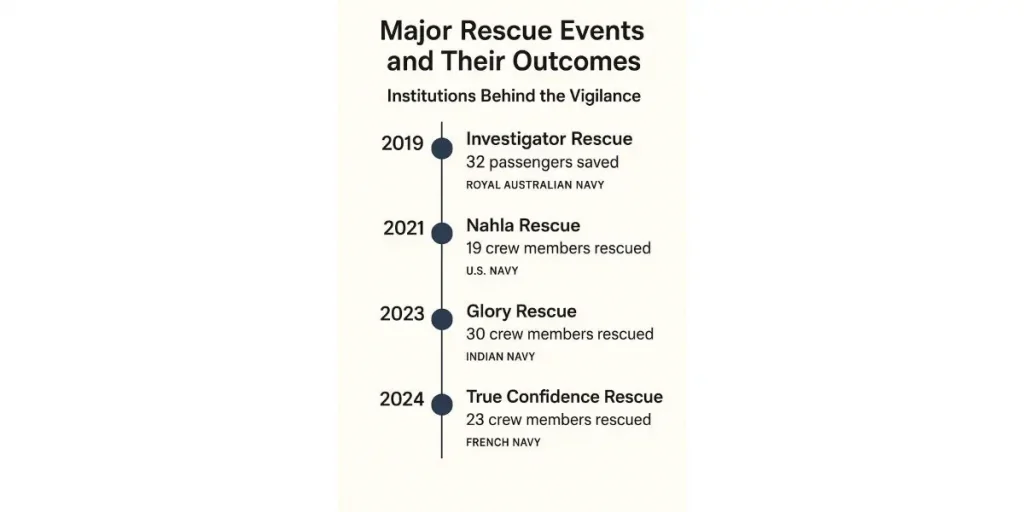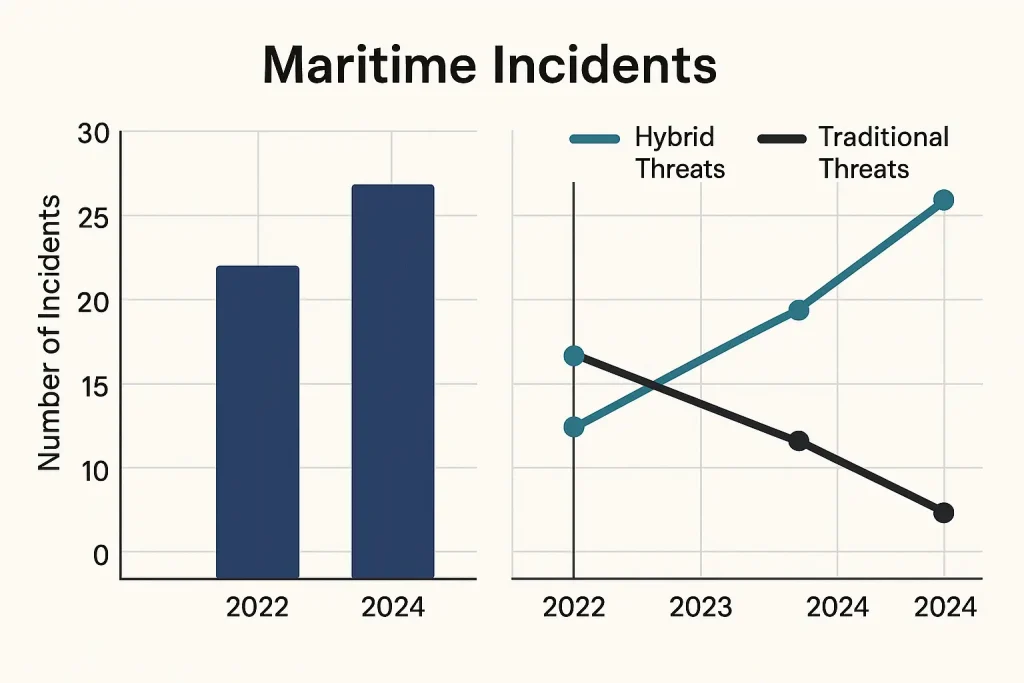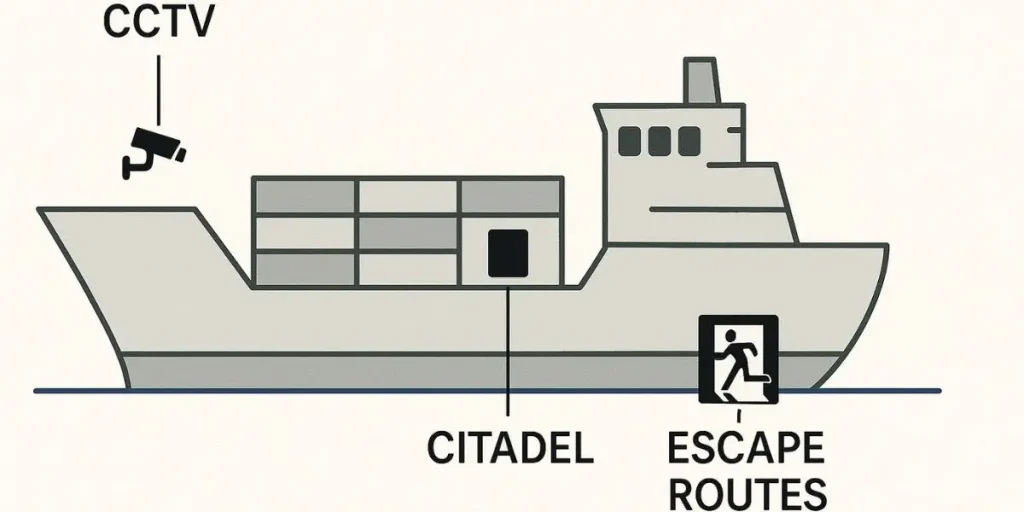The year 2024 tested the nerves of seafarers and the resolve of maritime forces worldwide. From piracy in the Gulf of Aden to missile attacks in the Red Sea, shipping lanes turned into battlegrounds. The Directorate General of Shipping (DGS) released the Maritime Security Review 2024, offering a deep dive into the threats faced and how India rose to defend its maritime borders and seafarers.
Whether you’re part of the shipping industry, a policymaker, or simply someone interested in global trade and security, this blog brings you the key highlights in simple, relatable language.
Why Maritime Security Mattered More Than Ever in 2024
With over 80% of global trade transported via sea, maritime routes are the veins of international commerce. But in 2024, these routes faced threats ranging from Houthi missile attacks to Somali piracy resurgence.
The Indian Ocean Region (IOR) remained at the center of global maritime interest. India, with its strategic position and large seafaring workforce, had a critical role in maintaining peace, responding to emergencies, and ensuring uninterrupted trade flows.
Types of Maritime Incidents
According to the DGS report, incidents affecting Indian seafarers were nearly evenly split across:
- Drone & Projectile Attacks – 25%
- Suspicious Vessel Activity – 25%
- Piracy & Armed Robbery – 25%
- Explosions & Hybrid Attacks – 25%
Most Affected Zones
Some of the world’s busiest and most sensitive maritime lanes turned volatile:
- Red Sea & Gulf of Aden – Houthi-linked missile and drone strikes
- Straits of Malacca & Singapore – Rising piracy incidents
- Gulf of Guinea – Resurgence in kidnappings and hijackings
- Bay of Bengal – Petty thefts near Indian and Bangladeshi ports

Heroes at Sea: Notable Rescue Operations
- MV Ruen Rescue (March 2024):
A daring 40-hour operation by Indian Navy MARCOS rescued 17 seafarers and captured 35 pirates 1400 NM from India’s coast. - MT Marlin Luanda (Jan 2024):
Indian crew extinguished a massive fire after a projectile hit. Awarded IMO Bravery Awards. - MV Lila Norfolk & MV Isa Star:
Indian Navy’s prompt action helped save Indian and foreign crews during pirate and explosion incidents.

- Information Fusion Centre – Indian Ocean Region (IFC-IOR)
- Mercantile Marine Domain Awareness Centre (MMDAC)
- Indian Navy & Coast Guard
These bodies coordinated intelligence, response efforts, and issued real-time advisories to ships at risk.
Data Speaks:
- 187 Indian nationals exposed to incidents
- Zero Indian fatalities thanks to onboard preparedness
- 75% of attacks occurred at night
- 65+ incidents on bulk carriers
- 60% of piracy within 12 nautical miles of shore
- 273 hybrid attacks, a five-fold jump from 2023

From Piracy to Hybrid Warfare: Changing Tactics
Modern-day piracy isn’t just about guns and hijacks. The landscape has shifted to include:
- Missiles
- Drones
- Water-borne IEDs (WBIEDs)
- Cyber threats
State-linked and ideologically motivated groups now target vessels from hundreds of nautical miles away, requiring new-age responses, surveillance, and countermeasures.
Onboard Safety Measures
- Reinforce citadels with better structural design
- Install infrared CCTV with AI alert systems
- Conduct regular crew drills
- Use digital connectivity to share real-time updates during emergencies
- Follow DGS Circular 08 of 2024 for ship reporting protocols

Conclusion: Anchoring Safety in Uncertain Waters
The Maritime Security Review 2024 shows that the ocean is no longer just a trade route—it’s a battleground of technology, resilience, and diplomacy. India’s performance this year was not just defensive but decisively proactive, marked by bravery, innovation, and international recognition.
As we sail into uncertain geopolitical tides, the blend of preparedness, coordination, and technological evolution will define how nations protect their maritime interests
FAQ Section
1.What was the most dangerous region for Indian ships in 2024?
The Red Sea and Gulf of Aden, due to the spike in missile and drone attacks, were the most volatile zones.
2.How did the Indian Navy protect ships in such areas?
Through real-time coordination with IFC-IOR, drone surveillance, and rapid deployment of naval ships and MARCOS teams.
3.Were there any casualties among Indian seafarers?
Remarkably, no Indian fatalities were reported, a testament to India’s robust security protocols and timely responses.
4.What’s the difference between traditional piracy and hybrid threats?
Traditional piracy involves hijacking ships using firearms or knives. Hybrid threats use technology, such as drones, missiles, or cyber tools, often launched from land or disguised vessels.
5.How can ships protect themselves in 2025?
By following DGS advisories, conducting drills, installing tech like AI-based CCTV, and maintaining active communication with authorities like MMDAC and IFC-IOR.
